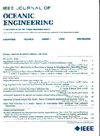Machine Learning Transmission Loss Predictions in Acoustic Field Experiments
IF 5.3
2区 工程技术
Q1 ENGINEERING, CIVIL
引用次数: 0
Abstract
This study evaluates the capabilities of three distinct transmission loss (TL) models to use as an on-board decision aid to identify locations in depth and range for an autonomous underwater vehicle (AUV) and an uncrewed surface vehicle (USV) to improve acoustic communications. AUVs and USVs are computationally and resource limited vehicles that require fast in-situ decisions to reposition. This work utilizes an experiment in August 2023 off the coast of Southern California of an SV3 Wave Glider communicating with a REMUS 100 vehicle equipped with a 25 kHz acoustic modem. Observations of TL across a range dependent bathymetry are used to evaluate various decision aid models that can provide acoustical awareness for the vehicles. Models are based on: first, simple approximations of sound intensity that decreases at range; second, a ray-based physics model Bellhop; and third, a machine learning (ML) decision tree model trained off-board the vehicle using Bellhop simulations. Predictions from the ML model show good agreement with the observed field data with an overall accuracy of 85.42%. Although there are discrepancies between locations of acceptable TL and those observed by the vehicles, the ML model is able to perform as well as the Bellhop model while improving the prediction speed of TL at an individual range and depth from 764.23 to 0.57 ms.声场实验中的机器学习传输损失预测
本研究评估了三种不同的传输损耗(TL)模型的能力,作为机载决策辅助工具,用于识别自主水下航行器(AUV)和无人水面航行器(USV)的深度和范围位置,以改善声学通信。auv和usv是计算和资源有限的车辆,需要快速的原位决策来重新定位。这项工作利用了2023年8月在南加州海岸进行的一项实验,SV3波浪滑翔机与配备25 kHz声学调制解调器的REMUS 100车辆进行通信。通过距离相关的水深测量来观察TL,用于评估各种决策辅助模型,这些模型可以为车辆提供声学感知。模型基于:首先,声强在距离上减小的简单近似值;二是基于光线的物理模型Bellhop;第三,机器学习(ML)决策树模型在车上使用Bellhop模拟进行训练。ML模型的预测结果与现场观测数据吻合良好,总体精度为85.42%。虽然可接受的TL位置与车辆观察到的位置存在差异,但ML模型能够表现得与Bellhop模型一样好,同时将单个范围和深度的TL预测速度从764.23 ms提高到0.57 ms。
本文章由计算机程序翻译,如有差异,请以英文原文为准。
求助全文
约1分钟内获得全文
求助全文
来源期刊

IEEE Journal of Oceanic Engineering
工程技术-工程:大洋
CiteScore
9.60
自引率
12.20%
发文量
86
审稿时长
12 months
期刊介绍:
The IEEE Journal of Oceanic Engineering (ISSN 0364-9059) is the online-only quarterly publication of the IEEE Oceanic Engineering Society (IEEE OES). The scope of the Journal is the field of interest of the IEEE OES, which encompasses all aspects of science, engineering, and technology that address research, development, and operations pertaining to all bodies of water. This includes the creation of new capabilities and technologies from concept design through prototypes, testing, and operational systems to sense, explore, understand, develop, use, and responsibly manage natural resources.
 求助内容:
求助内容: 应助结果提醒方式:
应助结果提醒方式:


